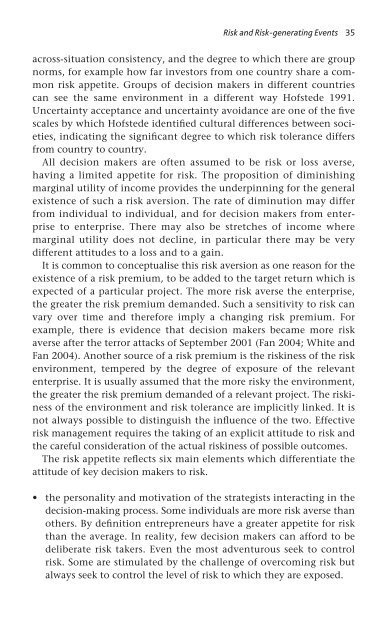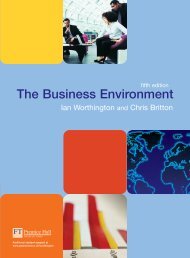Risk and Foreign Direct Investment - Index of
Risk and Foreign Direct Investment - Index of
Risk and Foreign Direct Investment - Index of
You also want an ePaper? Increase the reach of your titles
YUMPU automatically turns print PDFs into web optimized ePapers that Google loves.
<strong>Risk</strong> <strong>and</strong> <strong>Risk</strong>-generating Events 35<br />
across-situation consistency, <strong>and</strong> the degree to which there are group<br />
norms, for example how far investors from one country share a common<br />
risk appetite. Groups <strong>of</strong> decision makers in different countries<br />
can see the same environment in a different way H<strong>of</strong>stede 1991.<br />
Uncertainty acceptance <strong>and</strong> uncertainty avoidance are one <strong>of</strong> the five<br />
scales by which H<strong>of</strong>stede identified cultural differences between societies,<br />
indicating the significant degree to which risk tolerance differs<br />
from country to country.<br />
All decision makers are <strong>of</strong>ten assumed to be risk or loss averse,<br />
having a limited appetite for risk. The proposition <strong>of</strong> diminishing<br />
marginal utility <strong>of</strong> income provides the underpinning for the general<br />
existence <strong>of</strong> such a risk aversion. The rate <strong>of</strong> diminution may differ<br />
from individual to individual, <strong>and</strong> for decision makers from enterprise<br />
to enterprise. There may also be stretches <strong>of</strong> income where<br />
marginal utility does not decline, in particular there may be very<br />
different attitudes to a loss <strong>and</strong> to a gain.<br />
It is common to conceptualise this risk aversion as one reason for the<br />
existence <strong>of</strong> a risk premium, to be added to the target return which is<br />
expected <strong>of</strong> a particular project. The more risk averse the enterprise,<br />
the greater the risk premium dem<strong>and</strong>ed. Such a sensitivity to risk can<br />
vary over time <strong>and</strong> therefore imply a changing risk premium. For<br />
example, there is evidence that decision makers became more risk<br />
averse after the terror attacks <strong>of</strong> September 2001 (Fan 2004; White <strong>and</strong><br />
Fan 2004). Another source <strong>of</strong> a risk premium is the riskiness <strong>of</strong> the risk<br />
environment, tempered by the degree <strong>of</strong> exposure <strong>of</strong> the relevant<br />
enterprise. It is usually assumed that the more risky the environment,<br />
the greater the risk premium dem<strong>and</strong>ed <strong>of</strong> a relevant project. The riskiness<br />
<strong>of</strong> the environment <strong>and</strong> risk tolerance are implicitly linked. It is<br />
not always possible to distinguish the influence <strong>of</strong> the two. Effective<br />
risk management requires the taking <strong>of</strong> an explicit attitude to risk <strong>and</strong><br />
the careful consideration <strong>of</strong> the actual riskiness <strong>of</strong> possible outcomes.<br />
The risk appetite reflects six main elements which differentiate the<br />
attitude <strong>of</strong> key decision makers to risk.<br />
• the personality <strong>and</strong> motivation <strong>of</strong> the strategists interacting in the<br />
decision-making process. Some individuals are more risk averse than<br />
others. By definition entrepreneurs have a greater appetite for risk<br />
than the average. In reality, few decision makers can afford to be<br />
deliberate risk takers. Even the most adventurous seek to control<br />
risk. Some are stimulated by the challenge <strong>of</strong> overcoming risk but<br />
always seek to control the level <strong>of</strong> risk to which they are exposed.




